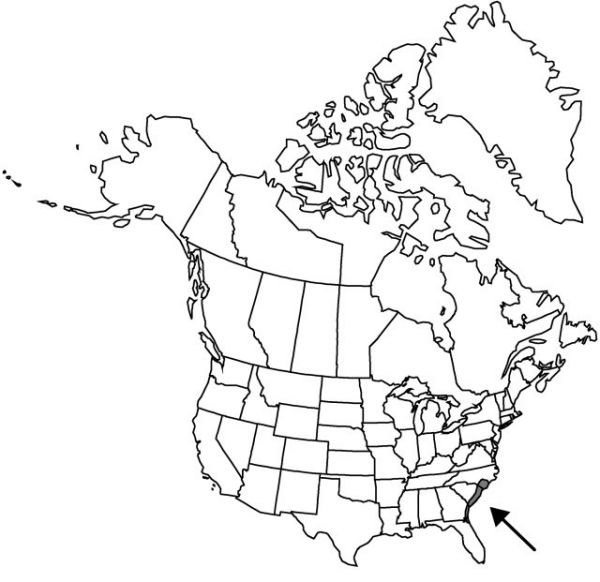Difference between revisions of "Hymenocallis crassifolia"
Appendix, 44. 1821.
FNA>Volume Importer |
FNA>Volume Importer |
||
| Line 12: | Line 12: | ||
|name=Hymenocallis palusvirensis | |name=Hymenocallis palusvirensis | ||
|authority=Traub | |authority=Traub | ||
| − | }}{{Treatment/ID/Synonym | + | }} {{Treatment/ID/Synonym |
|name=Pancratium crassifolium | |name=Pancratium crassifolium | ||
|authority=(Herbert) Schultes | |authority=(Herbert) Schultes | ||
| Line 30: | Line 30: | ||
|elevation=0 m | |elevation=0 m | ||
|distribution=Fla.;Ga.;N.C.;S.C. | |distribution=Fla.;Ga.;N.C.;S.C. | ||
| − | |discussion=<p>Hymenocallis crassifolia was described from a collection made near St. Mary, Georgia, by Herbert. The type specimen appears to have been lost for some time. However, collections that have been made from the nearby Satilla River fit the description well, as do other collections made from wetlands in the outer Coastal Plain of the Carolinas.</p><!-- | + | |discussion=<p><i>Hymenocallis crassifolia</i> was described from a collection made near St. Mary, Georgia, by Herbert. The type specimen appears to have been lost for some time. However, collections that have been made from the nearby Satilla River fit the description well, as do other collections made from wetlands in the outer Coastal Plain of the Carolinas.</p><!-- |
--><p>This species is distinguished in the field by coriaceous, liguliform leaves that are nearly erect throughout their length. The staminal corona is funnelform but gradually spreads with age, and the margin of the cup has small, irregular dentations.</p><!-- | --><p>This species is distinguished in the field by coriaceous, liguliform leaves that are nearly erect throughout their length. The staminal corona is funnelform but gradually spreads with age, and the margin of the cup has small, irregular dentations.</p><!-- | ||
| − | --><p>Hymenocallis crassifolia is difficult to distinguish on herbarium sheets from the closely allied H. duvalensis. They are separated by distribution and habitat, and it is sometimes apparent on the herbarium sheets that H. crassifolia tends to have a more slender perianth tube, smaller funnelform corona, bracts that are not noticeably long-acuminate, and often a less elongated bulb neck.</p> | + | --><p><i>Hymenocallis crassifolia</i> is difficult to distinguish on herbarium sheets from the closely allied <i>H. duvalensis</i>. They are separated by distribution and habitat, and it is sometimes apparent on the herbarium sheets that <i>H. crassifolia</i> tends to have a more slender perianth tube, smaller funnelform corona, bracts that are not noticeably long-acuminate, and often a less elongated bulb neck.</p> |
|tables= | |tables= | ||
|references= | |references= | ||
| Line 56: | Line 56: | ||
|publication year=1821 | |publication year=1821 | ||
|special status= | |special status= | ||
| − | |source xml=https://jpend@bitbucket.org/aafc-mbb/fna-data-curation.git/src/ | + | |source xml=https://jpend@bitbucket.org/aafc-mbb/fna-data-curation.git/src/8f726806613d60c220dc4493de13607dd3150896/coarse_grained_fna_xml/V26/V26_551.xml |
|genus=Hymenocallis | |genus=Hymenocallis | ||
|species=Hymenocallis crassifolia | |species=Hymenocallis crassifolia | ||
Revision as of 16:45, 18 September 2019
Bulb rhizomatous, narrowly ovoid, 2–5 × 1.5–3 cm; basal plate 1–2.5 cm; neck 3–9 cm; tunic light gray. Leaves deciduous, 3–5, nearly erect, (2.4–)3.5–6.8 dm × 1–2.5 cm, coriaceous; blade shiny green, liguliform, channeled in proximal 1/2, apex acute. Scape 3–5 dm, 2-edged, glaucous; scape bracts 2, enclosing buds, 2.5–5 cm × 7–12 mm; subtending floral bracts 2–3 cm × ca. 5 mm. Flowers 2–3, opening sequentially, fragrant; perianth tube green, 5–8(–10) cm; tepals slightly ascending, white, tinged green on keel, especially at base, (6–)7–9(–11.5) cm × 3–6 mm; corona white with small green eye, funnelform at full anthesis, then gradually spreading, shortly tubulose proximally, (2–)2.5–3.5 × 3.5–4.5 cm (unbroken on herbarium sheets), margins between free portions of filaments irregularly dentate, projections not prominent; free portions of filaments inserted on flat sinal base, suberect, white, 1.5–3 cm; anthers 1–2 cm, pollen golden; ovary green, ovoid, 0.8–1.5 cm × ca. 5 mm, ovules 2–3 per locule; style green in distal 1/2, rapidly fading to white proximally, (10–)13–18 cm. Capsules subglobose, 2–3 × 2–3 cm. Seeds elongate, 1.5–2 × 1–1.5 cm. 2n = 40.
Phenology: Flowering mid–late spring.
Habitat: Ditches, margins of streams and rivers, bogs, brackish marshes, alluvial woods
Elevation: 0 m
Distribution

Fla., Ga., N.C., S.C.
Discussion
Hymenocallis crassifolia was described from a collection made near St. Mary, Georgia, by Herbert. The type specimen appears to have been lost for some time. However, collections that have been made from the nearby Satilla River fit the description well, as do other collections made from wetlands in the outer Coastal Plain of the Carolinas.
This species is distinguished in the field by coriaceous, liguliform leaves that are nearly erect throughout their length. The staminal corona is funnelform but gradually spreads with age, and the margin of the cup has small, irregular dentations.
Hymenocallis crassifolia is difficult to distinguish on herbarium sheets from the closely allied H. duvalensis. They are separated by distribution and habitat, and it is sometimes apparent on the herbarium sheets that H. crassifolia tends to have a more slender perianth tube, smaller funnelform corona, bracts that are not noticeably long-acuminate, and often a less elongated bulb neck.
Selected References
None.